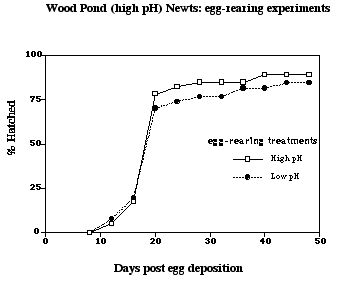Newt Evolution and Pond Chemistry
Acidification of aquatic and terrestrial ecosystems in the northeast United States due to increased atmospheric acid deposition has been a significant environmental problem for over 60 years. Amphibians are particularly vulnerable to acid precipitation due to their aquatic breeding habits and permeable skin. Low pH affects amphibian larval growth rate, embryonic development and distribution in both aquatic and terrestrial habitats.
Intraspecific variation and the possibility of adaptive evolution of amphibian populations in environments of different pH remain largely unexplored. These questions are all the more important in assessing the possible relationship between acid deposition and amphibian decline.
The red-spotted newt Notophthalmus viridescens is widespread in eastern North America. In southern Vermont, this salamander is found in ponds with a wide range of pH. My students and I have been studying six populations of newts from ponds of very different pH. The high pH ponds are in the foothills of the Taconic Mountains which are underlain by extensive limestone deposits. These ponds have had an average pH of 8.1 over the past four years. The low pH ponds are in the Green Mountain Plateau, with a granitic base with little buffering capacity. The average pH of these ponds has been 4.6 over the last four years.
The populations from these two groups of ponds provide an opportunity to investigate whether the newts have responded evolutionarily to different pH environments. Given that the pH of precipitation in the northeast has been low for over 60 years and given that newts exhibit fidelity to their natal ponds, it is likely that populations from different mountain ranges have been isolated in ponds of different pH for many generations.
For several years my students and I have been asking whether pond pH has served as a selective agent in the evolution of newts. Two questions are at the center of this research:
- What are the phenotypic differences among the newts of the two different pH ponds?
Sherman and Van Munster (2012)
- Are there heritable differences among the newts of the two different ponds?
In order to address this question, we have begun to raise newt eggs from newts of the two different pH ponds in water of different pH. For example, during the summer of 2000, we brought newts from Wood Pond (high pH) into the lab and got them to breed. We then reared those eggs in water with either a high pH (pH=8) or a low pH (pH= 4.5). There was a small difference in hatching success of the two groups of eggs: 89.2% for eggs reared in high pH and 84.4% for eggs reared in low pH water. These data are only preliminary.
In collaboration with chemist Janet Foley, we are studying chemical differences in addition to pH among the Taconic and Green Mountain ponds.